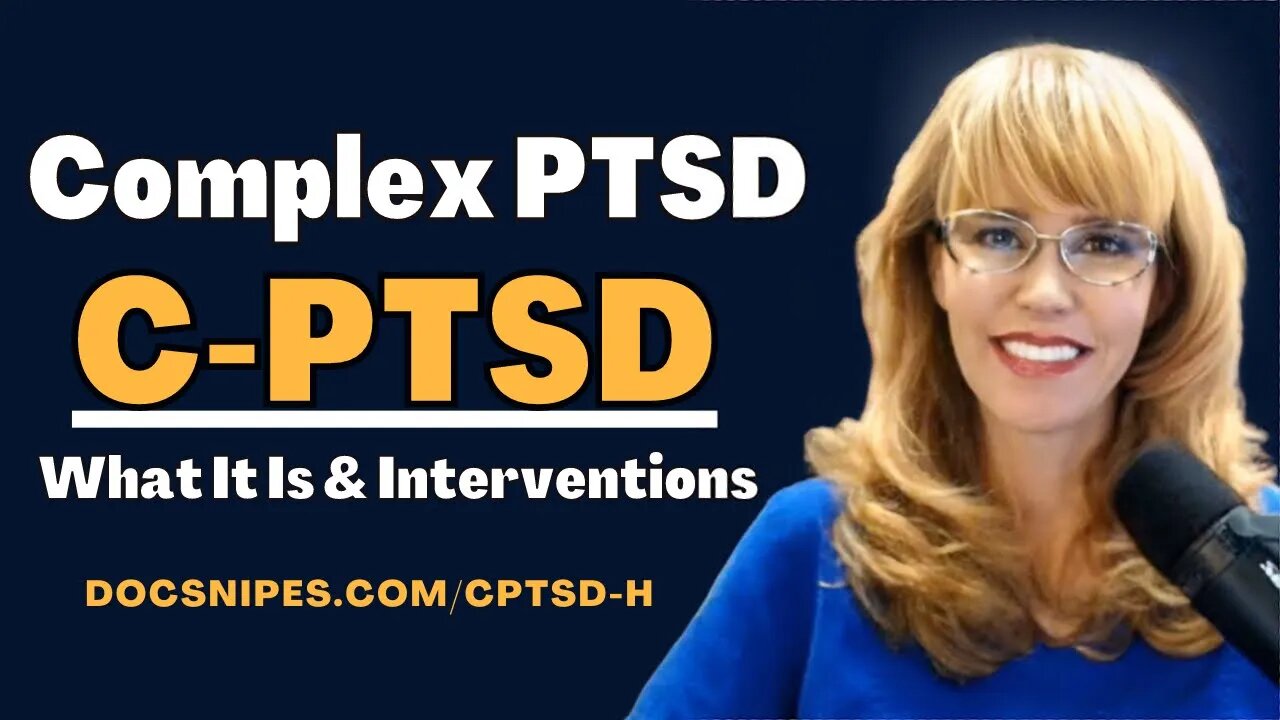Premium Only Content

Complex PTSD (CPTSD) What it is & Strategies to Cope
Complex PTSD (CPTSD) and Strategies to Cope: Read more below:
📢SUBSCRIBE & click the BELL to get notifications
💲 EARN Counseling and Social Work CEUs https://www.allceus.com/member/cart/index/product/id/336/c/
Unlimited CEUs $59 based videos at: allceus.com
Join channel & get access to perks:
https://www.youtube.com/channel/UCAE3JJi8tX7gfhZEXCUGd_A/join
The video is a BRIEF introduction to what CPTSD is, why it is different from PTSD, how it is related to trauma and why many people have difficulty recovering (HINT: They are trying to address the symptoms instead of the CAUSES of the symptoms) #CPTSD #complexptsd #trauma #BPD
Internal Family Systems Theory #IFS #EMDR #Yoga and #meditation all have their place in treatment of CPTSD but can be very triggering if not implemented carefully and at a time appropriate for the individual.
Unlike single incident PTSD, cPTSD creates a pervasive feeling of unsafeness and disempowerment in most situations. However, like PTSD and BPD, helping the person develop a sense of safety and empowerment then integrating the traumatic experiences can help decondition traumatic stimuli and integrate trauma memory fragments that are stored in the amygdala and throughout the body.
CPTSD: What It Is and Helpful Interventions
PTSD Occurs after a single event.
CPTSD is associated with multiple forms of prolonged/sustained or repeated interpersonal trauma
CPTSD resulted in significantly greater functional impairment than PTSD
Intro
CPTSD includes the core PTSD symptoms of re-experiencing, avoidance, mood alterations, cognitive alterations, hypervigilance and dysregulation in
Emotion regulation
Self-organization (including bodily integrity)
Relational security
Note: CPTSD is not accepted as a psychiatric diagnosis in the Diagnostic and Statistical Manual V
Intro
There is significant overlap between the symptoms of BPD and cPTSD
All of the new or revised PTSD symptoms (which also overlap with BPD symptoms) are cardinal features of cPTSD: Affect dysregulation, altered core beliefs about self, reckless or dangerous impulsive behavior, self-harm
2 BPD criteria related to attachment disorganization or insecurity are not included in the diagnosis of PTSD or cPTSD: terror of abandonment or rejection, and alternating idealization and devaluation*
Traumatic experiences and a compromised primary attachment have been hypothesized as key contributors to BPD
Adults with BPD also are at risk for abuse or re-victimization in adulthood
Treatment
Education Many people with CPTSD think that their symptoms represent an innate constitution and have not recognized the association with trauma.
Create safety
Develop somatic and emotional awareness (Yoga, meditation)
Empower with IFS to heal the parts of themselves that were developed in the context of trauma
Memory integration (EMDR)
Addressing underlying issues instead of simply struggling with symptoms in the present
Symptoms Safety & Empowerment
• Physical
• Dizziness or nausea when remembering the trauma
• Always tense
• Startling easy
• Difficulty sleeping
• Impulsive behaviors including self-harm
• Affective
• Emotional dysregulation /Lability
• Depression
• Anxiety
• Shame
• Guilt
• Feeling afraid for no obvious reason
• Cognitive
• Reliving the trauma through flashbacks and nightmares
• Difficulty concentrating
• A negative self-view
Symptoms
• Environmental
• Avoiding situations that remind them of the trauma
• Hypervigilance
• The belief that the world is a dangerous place
• Relational
• A loss of trust in the self or others
• Problems with maintaining relationships (switching, trust, rages)
• Feeling detached from oneself
• Feeling different from others
• Low levels of social support
• Rescuing
• Attracted to people who are emotionally unavailable
Summary
Ongoing or repetitive traumas alter the person’s schema, increase the number or trauma related stimuli, cause structural changes to the brain and promote the development of survival strategies such as dissociation which can lead to a pervasive sense of disempowerment and unsafeness.
These changes ultimately lead to alterations in the HPA-Axis and corresponding problems with emotional regulation, hypervigilance, concentration, relationships and more
Summary
Addressing the superficial symptoms without also healing the underlying causes of those symptoms is like injecting anesthetic to numb a broken leg, but never setting it.
CPTSD, PTSD and BPD are all strongly correlated to trauma. Addressing the symptoms the person is experiencing and the causes of those symptoms is far more important than arguing about a diagnostic label.
Until people feel safe in their skin as well as their environment, they will continue to experience symptoms.
NOTE: VIDEOS are NOT a replacement for medical advice or counseling from a licensed professional, but for educational purposes.
00:00 cPTSD
00:14 Intro
07:53 Treatment
13:28 Symptoms
27:28 Summary
-
 8:52
8:52
DocSnipes
1 year agoHow Cognitive Distortions Contribute to Violence
212 -
 1:02:45
1:02:45
Tundra Tactical
12 hours ago $30.48 earned🛑 KASH PATEL NEW ATF DIRECTOR??? Breaking News!!!! 🛑
94.8K14 -
 4:31:10
4:31:10
I_Came_With_Fire_Podcast
22 hours agoMy EURO Divorce | HOGG with a side of PAC | Foreign FUNDS Fudged
59.4K9 -
 37:44
37:44
Glenn Greenwald
19 hours agoGlenn On Tearing Down the Military Industrial Complex, Exposing Pro-Israel Indoctrination, and More | SYSTEM UPDATE #411
138K200 -
 4:04:20
4:04:20
Nerdrotic
18 hours ago $57.17 earnedAmazon Takes 007! Hollywood is Lost, Disney Cancels WHO? | Friday Night Tights 342 /w ItsAGundam
196K55 -
 43:27
43:27
Tucker Carlson
17 hours agoRay Dalio: America’s Hidden Civil War, and the Race to Beat China in Tech, Economics, and Academia
213K210 -
 56:56
56:56
Candace Show Podcast
18 hours agoEXCLUSIVE: Taylor Swift Will Be Deposed. | Candace Ep 150
248K200 -
 1:03:52
1:03:52
IsaacButterfield
14 hours ago $10.86 earnedRepublican Vs 25 Transgender Activists | Jewish Outrage | Lizzo Loses All the Weight
86.4K23 -
 1:10:23
1:10:23
Edge of Wonder
18 hours agoChinese Biochips Hacking Minds? Quantum Control & Journey Song Mandela Effect
101K9 -
 2:15:46
2:15:46
Quite Frankly
21 hours ago"Ghosts, Robotics, and OBE's" ft. Dr. Albert Taylor 2/21/25
90.1K19